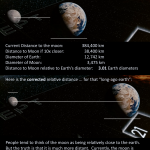
While I enjoy the new Cosmos series, I do get frustrated that the computer graphics can be exceedingly misleading. The relative distance of the earth and moon is one example. This happens to be a particularly big pet peeve for me (as anyone who has taken my game physics course will remember), so I made this graphic to help illustrate:
How far away do you think it is?
 But before you take a closer look, take a moment to think about your own notions of distance. How far away do you think the moon is from the earth? If the earth was the size of a basketball, how far away is the moon?
But before you take a closer look, take a moment to think about your own notions of distance. How far away do you think the moon is from the earth? If the earth was the size of a basketball, how far away is the moon?
People tend to think of the moon as being relatively close to the earth. In fact, my unscientific polling has shown that most think the distance to the moon is 2 to 4 earths away. But the truth is that the moon is much more distant.
Back to our basketball: A standard basketball is about 9.4 inches in diameter. Place our “basketball sized earth” directly under the net on a regulation sized NBA court. Where is the moon? At the 4-foot line? How about 6 feet away? Or maybe at the free throw line, 13 feet away?
No, the moon is actually all the way out at the 3-point line, 23.5 feet away. That is, you’d need 30 basketballs lined up side-to-side to the moon from our basketball sized earth.
The next question is how big is the moon at that scale? Half as big? The size of a softball maybe? Well, at that scale the moon would be only be 2.56 inches in diameter. That’d be slightly smaller than a baseball.
When you stop to think about that type of scale, you realize all our lunar accomplishments are that much more significant.

In the first episode (Standing Up in the Milky Way), Tyson states the following, “If you stood on the surface of that long ago earth, the moon would have looked a hundred times brighter; it was ten times closer back then, locked in a much more intimate gravitational embrace.”
That’s very poetic, but the computer graphics displayed as he narrates show the moon at about “one earth diameter” away. Now lets look at some numbers:
| Current Distance to the moon | 384,400 km |
| Distance to moon if 10x closer | 38,440 km |
| Earth Diameter | 12,742 km |
| Moon Diameter | 3,475 km |

You can see that travelling to the moon is a huge deal. It was huge in the 1960s and it is still a huge deal. On the one hand, its true that the laws of motion are extremely predictable at that scale. That is, other than the combined gravity of the earth, moon, and sun, all other outside forces will have a negligible effect.
On the other hand, if your calculations are off by the smallest margin, you’ll end up in the depths of space with no way to get back. There is a LOT of empty space out there. Now, click to take a closer look at that InfoGraph (on the left) and see just how misleading the Cosmos graphics are.
Am I nitpicking? Probably, but since Dr. Tyson pointed out that the earth is spinning the wrong direction in the Daily Show’s opening sequence I’m sure he understands my frustration.
Tyson on Daily Show’s Computer Graphics
Cosmos: A Spacetime Odyssey is a 2014 television series on Fox, hosted by Neil deGrasse Tyson and produced by Family Guy creator, Seth MacFarlane. This series is an update to the original “Cosmos: A Personal Voyage” hosted by Carl Sagan.

